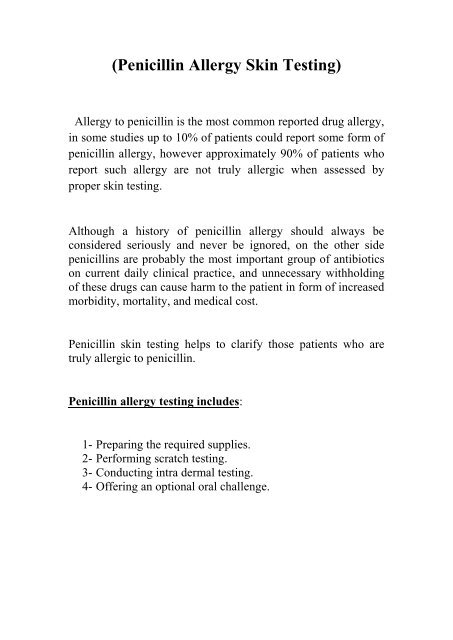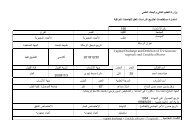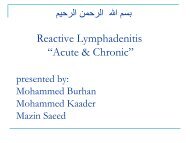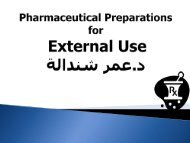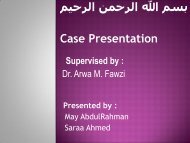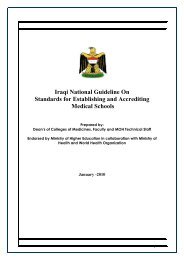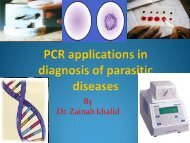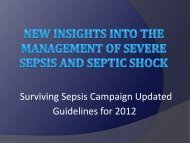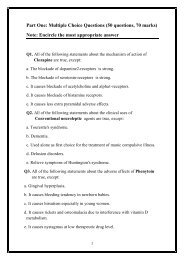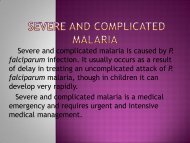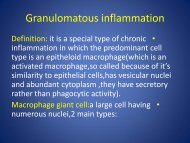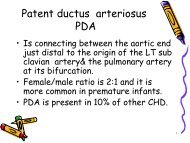(Penicillin Allergy Skin Testing)
(Penicillin Allergy Skin Testing)
(Penicillin Allergy Skin Testing)
Create successful ePaper yourself
Turn your PDF publications into a flip-book with our unique Google optimized e-Paper software.
(<strong>Penicillin</strong> <strong>Allergy</strong> <strong>Skin</strong> <strong>Testing</strong>)<strong>Allergy</strong> to penicillin is the most common reported drug allergy,in some studies up to 10% of patients could report some form ofpenicillin allergy, however approximately 90% of patients whoreport such allergy are not truly allergic when assessed byproper skin testing.Although a history of penicillin allergy should always beconsidered seriously and never be ignored, on the other sidepenicillins are probably the most important group of antibioticson current daily clinical practice, and unnecessary withholdingof these drugs can cause harm to the patient in form of increasedmorbidity, mortality, and medical cost.<strong>Penicillin</strong> skin testing helps to clarify those patients who aretruly allergic to penicillin.<strong>Penicillin</strong> allergy testing includes:1- Preparing the required supplies.2- Performing scratch testing.3- Conducting intra dermal testing.4- Offering an optional oral challenge.
Required supplies:1-Proper reagents including:-Benzylpenicilloyl (the major antigenic determinant inpenicillin allergic individuals)-Dilute <strong>Penicillin</strong> G 10,000 U/ml- Histamine for positive control-Sterile diluents negative controlIt is important to make sure that the patient does not take anyform of anti histamine during the last 48 hours.2- Scratch testing device.3- 26- 28 gauge syringe with label.(Label each syringe before withdrawing the reagent)4- Alcohol swabs and skin marking pen.Although rare, skin testing can induce anaphylaxis, so it isimportant to have the facility to treat anaphylactic shock, sothere should be:-Stethoscope and sphygmomanometer.-Adrenalin 1:1000-Hydrocortisone.-Antihistamines.No combination of testing can offer a 100% diagnostic accuracyso it is important to take careful history when evaluating apatient with history of penicillin allergy.
Patients with history of recent and sever anaphylaxis topenicillin and negative skin testing should be managed verycarefully and if medically appropriate continue with otherantibiotics.Patients with severe skin reaction to penicillin should not beexposed to skin testing.Begin with Scratch testing as a screening test; this is conductedwith diluted <strong>Penicillin</strong> G, Benzylpenicilloyl, Saline( as anegative control), and Histamine( as positive control).Use the ventral aspect of the patients forearm,Clean the skin with alcohol swabs to prepare the skin surface.Mark the skin to clearly identify where each reagent will beplaced.Avoid cross contaminationPlace one drop of the proper reagent on each area, after that usea scratch testing device to scratch the surface of the skin.Apply minimum pressure to break the top layer of the skin.Read the results within 15-20 minutes, but never delay readingas the results can wane after 20 minutes.Read the histamine result first as a positive reaction to histamineis required to move forward in reading the test.If you do not see a reaction to histamine within 15 minutes thepatient has likely been taking antihistamine and the test shouldbe stopped and conducted on another day because results willnot be valid.If the patient reacted to histamine by appearance of wheel andsome flare the test is valid and you can move forwarded inreading the results.
A positive test will result in Induration of greater than 3 mmthan the negative control.If the test is positive the patient is labeled as allergic topenicillin. (No need to go to dermal testing).If the result of scratch test is negative you can proceed to intradermaltesting.This is conducted with Benzylpenicilloyl, <strong>Penicillin</strong> G andnegative diluents control.Clean the skin with alcohol and mark the test area appropriatelyas with scratch test.Raise a 2-3mm bleb using the proper reagent, then mark theedge of it by circling its parameter.Watch for any change outside that original bleb, the back of theupper arm can be used instead of the forearm if it was morecomfortable to the patient.Read the results within 15-20 minutes as with the scratch test.If there was no increase in the size of the original bleb, and noreaction greater than the control site, the test is reported asnegative.A positive test is characterized by:-Increase in the size of the original bleb with wheel diameter of3mm or larger than the diluents control.-Itching and flare are commonly present.If equivocal result were observed with wheel only slightly largerthan the original injection bleb, then test can be repeated.After a negative test, an oral challenge with oral dose ofpenicillin can be started with careful observation of the patientfor about one hour.Oral challenge is safer than Injectable dose challenge.


